Pincushion Cactus, Beehive Cactus (Coryphantha)
The Coryphanthas have been embroiled in a taxonomic debate/war for over a century. Some botanists don’t believe there’s any such thing, and they place everything in with the Mammillarias. Others think there are quite a few. For example, Dr. Powell’s 2004 Cacti of Texas lists more than 15 different Corypanthae. But the same author’s Flowering Plants of Trans-Pecos (2018) lists only 5, and that count is for the entire state. The latest official count is 2. We’ll go with that.
Initially, and the best approach from our perspective as amateurs, classification relied on visible attributes of the plant. But it seems that visible attributes of the plants are so variable as to be almost meaningless in the field. Dr. Reto F. Dicht and Adrian D. Lüthy spent 12 years studying this genera and here is what they came up with.
There are only 3 characteristics of the plant that can define it as a Coryphantha. These are:
-
Flowers grow from the apex of the plant
-
Tubercles (at least sometimes) have a groove on one side.
-
Seed coating has a net-like appearance.
There are problems with all three. For example,
-
you cannot always see the plant in bloom
-
tubercles only develop grooves when the tubercle is sexually mature, so any plant may have all, none, or a mix of grooved and ungrooved tubercles
-
How many seed coats have you studied under a microscope?
Fortunately, the whole genus has now been reduced to only 2 species, and they look completely different from one another. So take all the following description with a grain of salt…
Long Mama, Big-Needle Pincushion Cactus (Coryphantha macromeris)
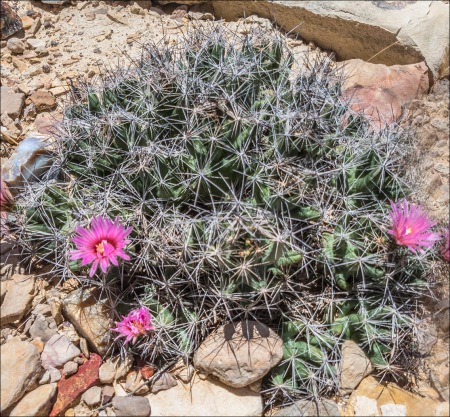 This plant is widespread throughout the Trans-Pecos. It prefers level sandy alluvium, gravel benches, or clay – it is rarely seen on steep rocky slopes or in crevices.
This plant is widespread throughout the Trans-Pecos. It prefers level sandy alluvium, gravel benches, or clay – it is rarely seen on steep rocky slopes or in crevices.
Mature plants are clumped and form many-stemmed mats or mounds. Tubercles are conspicuous and look somewhat flaccid and soft-skinned.
Spines: In the Trans-Pecos area, there are 4 centrals, 1–2¾ inch long, and 12–14 radials, short, white and weakly appressed. The lowermost central spine is porrect – others are diffuse or weakly appressed or descending; Some tubercles have grooves, but not all.
Flowering occurs sporadically May–September. The blossoms are bright rose-pink to magenta, up to 2 inches long and 3 inches wide. Floral remnants are persistent.
Fruits are green when mature and can be over an inch long.
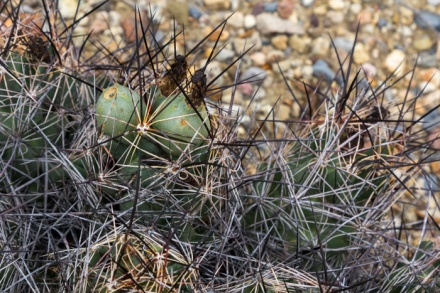 The Big-Needle Pincushion Cactus is a “gypsovag,” and is capable of living in even the most gypsophilic soils.
The Big-Needle Pincushion Cactus is a “gypsovag,” and is capable of living in even the most gypsophilic soils.
Pineapple Cactus (Coryphantha robustispina var. scheeri)
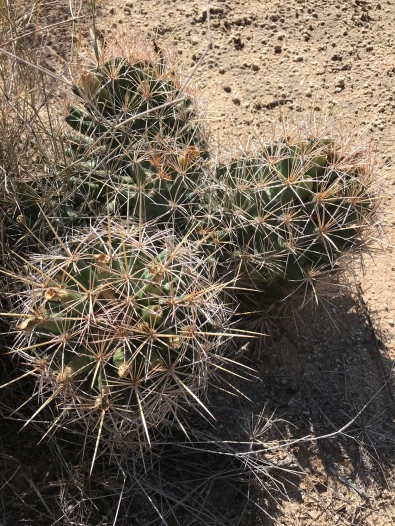 The Pineapple Cactus lives throughout most of the Trans-Pecos, preferring altitudes of 2700–5200 feet. It is usually seen as scattered individuals. It has been reported to grow along the Rio Grande on the eastern side of national park and in the state park.
The Pineapple Cactus lives throughout most of the Trans-Pecos, preferring altitudes of 2700–5200 feet. It is usually seen as scattered individuals. It has been reported to grow along the Rio Grande on the eastern side of national park and in the state park.
Most radial spines are thin, light-colored and appressed but the central spines are significantly larger and porrect. Young/some plants may be missing the large central spine.
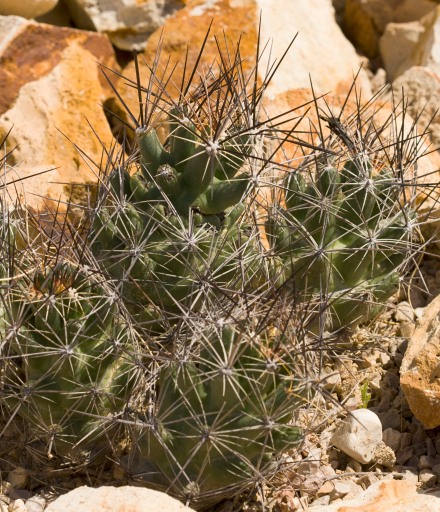 Flowers appear from April to June and often have a reddish throat. Filaments are reddish supporting yellow anthers. The flower may fade to pinkish yellow as it ages. Fruits are light green when ripe and aromatic.
Flowers appear from April to June and often have a reddish throat. Filaments are reddish supporting yellow anthers. The flower may fade to pinkish yellow as it ages. Fruits are light green when ripe and aromatic.

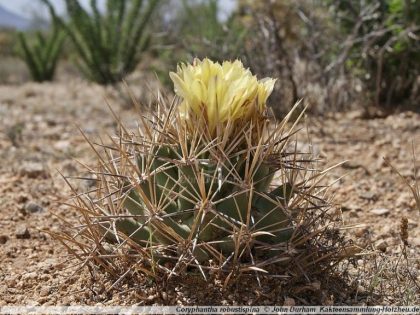



Cool wwrite-up! I would love to see the net-like covering on their seeds. May need to paint it… Our new website: artplaceon963.com
Deborah Douglas, M. D. (210) 845-3077
>